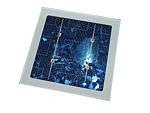Solar shingle
Solar shingles, also called photovoltaic shingles, are solar panels or solar modules designed to look like and function as conventional roofing materials, such as asphalt shingle or slate, while also producing electricity. Solar shingles are a type of solar energy solution known as building-integrated photovoltaics (BIPV).
There are several varieties of solar shingles, including shingle-sized solid panels that take the place of a number of conventional shingles in a strip, semi-rigid designs containing several silicon solar cells that are sized more like conventional shingles, and newer systems using various thin-film solar cell technologies that match conventional shingles both in size and flexibility. There are also products using a more traditional number of silicon solar cells per panel reaching as much as 100 watts DC rating per shingle.[1]
Solar shingles are manufactured by several companies[2] but the two main manufacturers of solar roof shingles are Dow and CertainTeed.[3] Other active companies in the US include SunTegra Solar Roof Systems,[4] and Atlantis Energy Systems (asphalt and slate systems),[5]
History
Commercial solar shingles were first available in 2005. In a 2009 interview with Reuters, a spokesperson for the Dow Chemical Company estimated that their entry into the solar shingle market would generate $5 billion in revenue by 2015 and $10 billion by 2020.[2] Dow solar shingles first became available in Colorado, in October 2011, but the company stopped selling them only five years later in mid-2016.[6]
Description
Solar shingles are photovoltaic modules, capturing sunlight and transforming it into electricity. Most solar shingles are 12 by 86 inches (300 by 2,180 mm) and can be stapled directly to the roofing cloth. When applied they have a 5 by 86 inches (130 by 2,180 mm) strip of exposed surface. Different models of shingles have different mounting requirements. Some can be applied directly onto roofing felt intermixed with regular asphalt shingles while others may need special installation.
Some manufacturers, such as DOW Chemical Company, use solar thin-film technologies, such as CIGS to produce electricity, which are less common in the solar industry than silicon-based cells. Other manufacturers, such as CertainTeed and SunTegra, have chosen to use the industry-standard monocrystalline or polycrystalline silicon solar cells in their Apollo II and SunTegra Shingle, respectively. The installation methods for some solar shingle solutions can be easier than traditional panel installations because they avoid the need to locate rafters and install with a process much more similar to asphalt shingles than standard solar panels.
Solar shingled roofs tend to have a deep, dark, purplish-blue or black color, and therefore look similar to other roofs in most situations. Tesla Solar has developed shingles in several styles to better match traditional roofs.[7] Homeowners may prefer solar shingles because they avoid having large panels on their roofs.[8]
Cost
The cost of solar shingles can range from $4.00 per Watt up to $12.00 per Watt installed depending on the manufacturer, technology used, and system size. As of Q3 of 2015, the average cost of a traditional, roof-mounted residential solar panel installation in the United States was just above $3.50 per Watt, according to the Solar Energy Industry Association.[9] While solar shingles are typically more expensive to install than traditional solar panels, some companies in recent years since 2014 have made strides to lessen the gap between the installed cost of going solar with panels versus going solar with shingles.
According to Dow Chemical Company reports, a typical residential install consisting of 350 solar shingles can cost at least $20,000; however, federal and state incentives depending on the location might significantly bring down the cost.[10]
Solar contractors typically offer homeowners a full-service price for solar installation, which includes equipment purchasing, permit preparation and filing, registration with the local utility company, workmanship warranties, and complete on-site installation. Because photovoltaic solutions produce power in the form of direct current (DC) and the standard in homes is alternating current (AC), all grid-connected solar installations include an inverter to convert DC to AC.
Availability
As of 2015, companies currently offering solar shingles in the United States include Dow,[11] CertainTeed,[12] SunTegra Solar Roof Systems,[4] and Atlantis Energy Systems (asphalt and slate systems).[5] Other companies that may be active include Sun Energy Engineering,[13] and OkSolar.com.[14] Tesla Solar entered the solar roof market in 2016.
In 2015, SunTegra Solar Roof Systems[4] completed its first installation in Canada with a homebuilder on the first net zero home in London, Ontario.
Former companies include Uni-Solar, which filed for bankruptcy in 2012, and Pfleiderer-Dachziegelwerke.[15]
Dow announced on June 28, 2016, that it will cease manufacturing POWERHOUSE™ modules.[16]
See also
- Building-integrated photovoltaics
- Energy development
- Green technology
- Solar energy, Solar Roof Tiles
References
- ↑ "SunTegra Solar Shingle 100W". SunTegra Solar. Retrieved 28 January 2016.
- 1 2 Goldstein, Matthew (2009-10-05). "Dow to sell solar shingle, sees huge market". Reuters. Retrieved 2009-10-08.
- ↑ List of Solar Roof Shingle Manufacturers.
- 1 2 3 SunTegra Solar Roof Systems by Integrated Solar Technology
- 1 2 Atlantis Energy Systems
- ↑ Dow to stop manufacturing Powerhouse Solar Shingles at Midland plant
- ↑ Tesla Solar
- ↑ Solar Shingles
- ↑ "SEIA Market Insight Report Q3 2015". SEIA.
- ↑ "Sun Roof: Solar Panel Shingles Come Down in Price, Gain in Popularity". Scientific American. Retrieved 2015-12-15.
- ↑ "Dow Powerhouse". Dow. Retrieved 1 December 2014.
- ↑ CertainTeed Apollo line
- ↑ Sun Energy Engineering
- ↑ OkSolar.com
- ↑ Lenardic, Denis (3/7/2013). "Roof-integrated Photovoltaic Modules". Retrieved 1 December 2014. Check date values in:
|date=(help) - ↑ http://client.dow.com/dowpowerhouse
